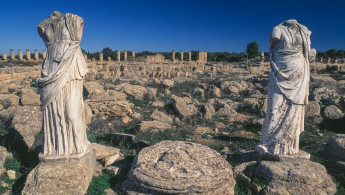Extremely rare 2,000-year-old statue looted from Libya returned by UK
An extremely rare and valuable ancient statue illegally smuggled from Libya to the UK in 2012 is to be returned to the North African country with the assistance of the British Museum.
The well-preserved statue, dating back to the 2nd century BC and thought to depict the Greek goddess Persephone appears to have been found affixed to a tomb in the ruins of the city of Cyrene in eastern Libya.
It is believed to have been illicitly excavated in 2012, following the revolution which overthrew longtime Libyan dictator Muammar Al-Qaddafi.
Cyrene was a port established by ancient Greeks in what is now eastern Libya and many examples of rare and unique funerary statues have been found there.
 |
| The statue of Persephone is stunningly detailed and well-preserved [Libyan Embassy in London] |
The statue, which was turned over to the Libyan embassy in London last month, shows Persephone holding a small doll and wearing snake-shaped bracelets on her wrists, making it “one of the rarest of the Cyrenaican funerary statue finds” according to the British Museum.
The statue was discovered in a warehouse near London’s Heathrow Airport in 2013. A Jordanian businessman has tried to import it to the UK, inaccurately declaring that it was found in Turkey and was worth £72,000 (US$102,000), The Independent reported.
Experts from the British Museum were called to examine the statue after customs officials became suspicious and seized it.
Read also: Police arrest Spanish art experts for selling Libya antiquities looted by IS
In 2015, a British judge ruled that it “belonged to the state of Libya” after hearing evidence from British museum experts.
Peter Higgs, a curator from the museum, told The Guardian how amazed he was when he saw the statue.
“It is stunning. It is a beautiful, three-quarter-length statue, very well preserved with just a few fingers missing. It is technically brilliant in the way it has been carved, with very sharp details, and the face is very well preserved considering many Greek statues have lost noses,” he said.
The snake bracelets on the statue probably represent death and rebirth, The Guardian reported, while the doll carried by the figure may represent a souvenir carried from this world to the next.
“There are other statues, most of which are still in Libya, in museums. This I personally think is one of the best in terms of preservation and carving quality,” Higgs added.
The statue will now be taken to a museum in Libya and be displayed as a “star piece”, Higgs said.
Hartwig Fisher, the director of the British museum said, “An important part of the museum’s work on cultural heritage involves our close partnership with law enforcement agencies concerned with illicit trafficking. This case is another good example of the benefits of all parties working together to combat looting and protect cultural heritage.”
Follow us on Facebook, Twitter and Instagram to stay connected




 Follow the Middle East's top stories in English at The New Arab on Google News
Follow the Middle East's top stories in English at The New Arab on Google News


